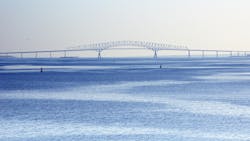The collapse of Baltimore’s Francis Scott Key Bridge will significantly impact trucking operations, both regionally and nationwide.
The bridge’s collapse not only limited traffic around major Maryland distribution centers but also shut down the nation’s largest port for roll-on/roll-off cargo. Sudden diversions, congestion, and longer travel distances will make handling some types of freight more expensive, according to industry analysts who spoke to FleetOwner on March 26.
“The Key Bridge and Port of Baltimore are critical components of our nation’s infrastructure and supply chain,” Sean McNally, VP of public affairs and press secretary for the American Trucking Associations, told FleetOwner on behalf of ATA. “Aside from the obvious tragedy, this incident will have significant and long-lasting impacts on the region.
See also: Port Blocked by Baltimore Bridge Collapse is Key Hub for US Shipping
About the bridge collapse
The Francis Scott Key Bridge collapsed early Tuesday morning after a container ship had crashed into the bridge.
The crash sent part of the structure and several vehicles into the river below. The debris also cut off ocean access for the Port of Baltimore.
Emergency response teams were still working through Tuesday to gauge the event’s destruction and begin recovery efforts.
How does the collapse affect freight movement?
The collapse affects the operations of several major freight assets in the area. Following the bridge’s collapse, the Francis Scott Key Bridge and the Port of Baltimore both shut down.
“Nearly 4,900 trucks travel the bridge each day, with $28 billion in goods crossing every year,” McNally said. “Trucks moving hazardous materials will now be subject to roughly 30 miles of detours around the City of Baltimore because they are prohibited from using the city’s tunnels. This will add significant cost in time, fuel, and delays for trucks traveling through the region, on top of the disruption that a closure of the Port of Baltimore will inflict on our economy.”
The bridge
The bridge is a part of Interstate 695 and is next to the Port of Baltimore. Both the bridge and the Port of Baltimore are major assets for freight movement in the region. More than 11 million vehicles cross the bridge each year.
The port
The Port of Baltimore is a U.S. shipping port that, with the collapse of the bridge, has lost access to and from the ocean.
“It’s the 13th largest port in the country for containers, but it’s the largest port in the country for roll-on, roll-off equipment,” Dean Croke, principal analyst for DAT Freight & Analytics, told FleetOwner.
Roll-on roll-off (Ro/Ro) equipment uses ships designed to move wheeled freight or anything that can drive on or off a ship. This includes cars, trucks, tractors, and farm machinery. Only certain U.S. ports can accommodate Ro/Ro shipping.
“I think that’s the bigger issue... it’s not just a container port. It’s the largest Ro/Ro port in the country,” Croke said. “You can draw a straight line from Baltimore straight across to the Midwest farming belt, and I think that’s the bigger implication on the trucking industry.”
Sparrow’s Point
Just east of the bridge lies Sparrows Point, an unincorporated Maryland community that hosts several major distribution centers and warehouses.
According to a 2019 Bloomberg article, the region has boomed in commercial real estate activity over the last decade. Sparrows Point now hosts two Amazon fulfillment centers as well as facilities for FedEx, Volkswagen, BMW, Home Depot, and more.
The collapse of the bridge severely limited access to and from these distribution centers.
How does the collapse affect fleets?
The bridge collapse will cause local traffic congestion, limit local warehouses’ ability to move freight, and displace a significant amount of Ro/Ro cargo.
Local traffic
The Maryland Transportation Authority is asking motorists to avoid the I-695 southeast corridor. To cross the harbor, it recommends using the Baltimore Harbor Tunnel on I-95 or the Fort McHenry Tunnel on I-895 for alternative routes.
However, MDTA prohibits vehicles carrying certain hazardous materials from using the tunnels. This includes propane gas in excess of 10 pounds per container (or a maximum of 10 containers), bulk gasoline, explosives, or significant amounts of radioactive materials. Vehicles carrying these materials should instead use I-695 around the tunnels.
According to CBS News, the bridge was originally constructed after the Baltimore Harbor Tunnel had reached capacity and experienced daily heavy congestion.
The bridge collapse will have a major impact on traffic, Herman Funk Jr., general counsel for Cowan Systems, told FleetOwner.
Cowan, No. 61 on the 2024 FleetOwner 500: For Hire, is a truckload carrier operating primarily in the eastern half of the U.S. Cowan also has two agents that work in the Port of Baltimore.
“All the traffic is going to have to be rerouted either around the beltway—and the beltway is 30 or 40 miles around—or through kind of antiquated tunnels under the harbor in Baltimore,” Funk said. “So that’s going to have a major impact on traffic.”
The tunnels also introduce clearance challenges for drivers.
“We’re going to have to pay a lot of attention to the restrictions in the tunnels,” Funk said. “One of those tunnels has a height restriction, which is going to affect tractor-trailers. And both of the tunnels have hazmat restrictions.”
The I-895 Baltimore Harbor prohibits vehicles above 162 inches tall and 96 inches wide. The I-195 Fort McHenry Tunnel prohibits vehicles exceeding 174 inches tall and 132 inches wide. MDTA is now posting route/transportation updates on a webpage dedicated to Key Bridge news.
The delays caused by congestion will be noticeable in the area, but won’t have significant national effects, according to Croke.
“If you’ve ever driven in Baltimore, it’s congested even at the quietest of times. I think the impact on just general commuter traffic and truck traffic will be observable,” Croke said. “But remember that we’ve also got excess truckload capacity in the broader market. There’s still more trucks than loads in the market, so some of the delays in moving freight out of Baltimore will be absorbed by that excess capacity.
“It won’t suddenly create a shortage of trucks necessarily across the country, but it’ll be more acute in the Baltimore area for drayage trucks that can’t move containers off the port or big trucks that are trying to move machinery,” Croke said. “There’ll be some acute shortages until the vessels redirect to other ports.”
Roll-on/roll-off cargo
According to Croke, the bigger impacts on fleet operations will come from the Ro/Ro cargo displacement.
“It’s a really big deal at this time of the year because this is planting season, nursery season, construction season—farming activity ramps up,” Croke said. “Spring usually means that we see peak imports of farm machinery and equipment, forklifts, and anything to do with building construction and agriculture. It peaks in March, and this will impact some of those imports that are still coming in.”
Because only certain ports can accommodate Ro/Ro cargo and because the nation’s largest Ro/Ro port suddenly shut down, shippers will need to divert much of their cargo to further destinations. This diverted cargo will cause some congestion at other Ro/Ro ports.
“From a freight perspective, any of those ships that divert to Baltimore or to other ports will have to give it to a port further south, potentially. And that just means more transit time for trucks and higher cost,” Croke said. “Not just from a distance perspective, but because you’ve got more wait time.”






